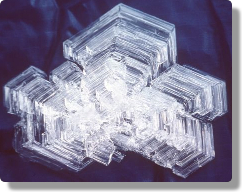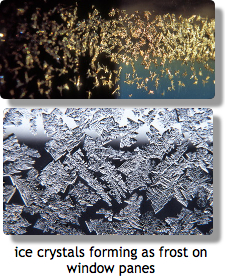
|

|


What happens inside a cloud?
Micro-scale Processes - Ice Crystal Formation
 The formation of ice crystals is essential for precipitation in middle and high
latitudes, where clouds extend upward into regions where the air temperature is
well below freezing ("cold clouds").
As with condensation, freezing requires a
nucleus. In pure water
droplets, molecules inside the droplet will join together in a rigid pattern to
form an ice embryo when temperatures are just below freezing. However, the
process of freezing releases heat. This and other thermal agitations break up
the ice embryo, so the droplet needs to be below freezing in order for the
entire droplet to freeze.
The formation of ice crystals is essential for precipitation in middle and high
latitudes, where clouds extend upward into regions where the air temperature is
well below freezing ("cold clouds").
As with condensation, freezing requires a
nucleus. In pure water
droplets, molecules inside the droplet will join together in a rigid pattern to
form an ice embryo when temperatures are just below freezing. However, the
process of freezing releases heat. This and other thermal agitations break up
the ice embryo, so the droplet needs to be below freezing in order for the
entire droplet to freeze.
 Small cloud droplets begin to freeze between -15 and -9 C (5 to 16 F), and large
cloud droplets begin to freeze between -8 and -4 C (18 to 25 F). In tall
clouds, there is a combination of ice and water between -40 and 0 C (-40 to
Small cloud droplets begin to freeze between -15 and -9 C (5 to 16 F), and large
cloud droplets begin to freeze between -8 and -4 C (18 to 25 F). In tall
clouds, there is a combination of ice and water between -40 and 0 C (-40 to
32 F). Above -40 C (also -40 F), the cloud is "glaciated", meaning it only contains ice. Next page -> Micro-scale processes - ice crystal formation continued
Links and resources
Micro-scale Processes - Ice Crystal Formation
 The formation of ice crystals is essential for precipitation in middle and high
latitudes, where clouds extend upward into regions where the air temperature is
well below freezing ("cold clouds").
As with condensation, freezing requires a
nucleus. In pure water
droplets, molecules inside the droplet will join together in a rigid pattern to
form an ice embryo when temperatures are just below freezing. However, the
process of freezing releases heat. This and other thermal agitations break up
the ice embryo, so the droplet needs to be below freezing in order for the
entire droplet to freeze.
The formation of ice crystals is essential for precipitation in middle and high
latitudes, where clouds extend upward into regions where the air temperature is
well below freezing ("cold clouds").
As with condensation, freezing requires a
nucleus. In pure water
droplets, molecules inside the droplet will join together in a rigid pattern to
form an ice embryo when temperatures are just below freezing. However, the
process of freezing releases heat. This and other thermal agitations break up
the ice embryo, so the droplet needs to be below freezing in order for the
entire droplet to freeze.
 Small cloud droplets begin to freeze between -15 and -9 C (5 to 16 F), and large
cloud droplets begin to freeze between -8 and -4 C (18 to 25 F). In tall
clouds, there is a combination of ice and water between -40 and 0 C (-40 to
Small cloud droplets begin to freeze between -15 and -9 C (5 to 16 F), and large
cloud droplets begin to freeze between -8 and -4 C (18 to 25 F). In tall
clouds, there is a combination of ice and water between -40 and 0 C (-40 to32 F). Above -40 C (also -40 F), the cloud is "glaciated", meaning it only contains ice. Next page -> Micro-scale processes - ice crystal formation continued
Links and resources
